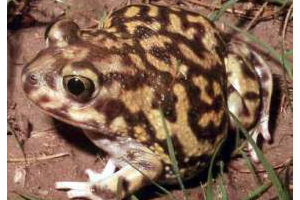A newly laid Couch’s spadefoot egg can develop into a tiny land-dwelling toadlet in just one to two weeks.
Photo Credit: Geoffrey A. Hammerson
Scaphiopus couchii
Common Name: Couch's spadefoot
Other Common Names: Couch spadefoot
Animal Guild: Amphibian
Class > Order > Family: Amphibia > Anura > Scaphiopodidae
